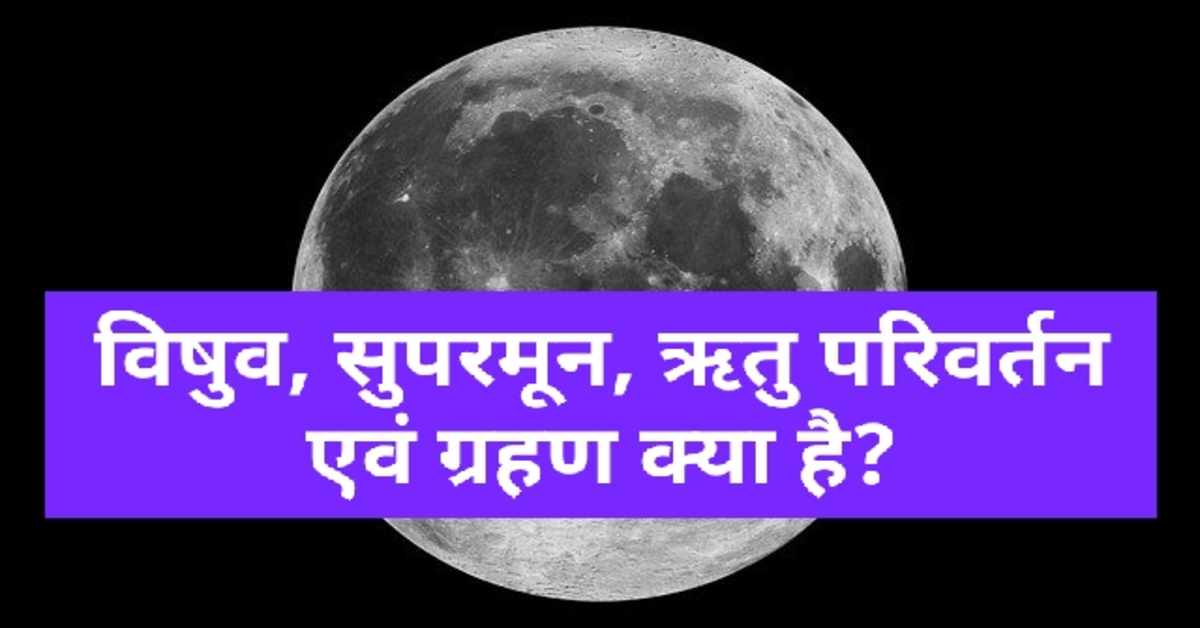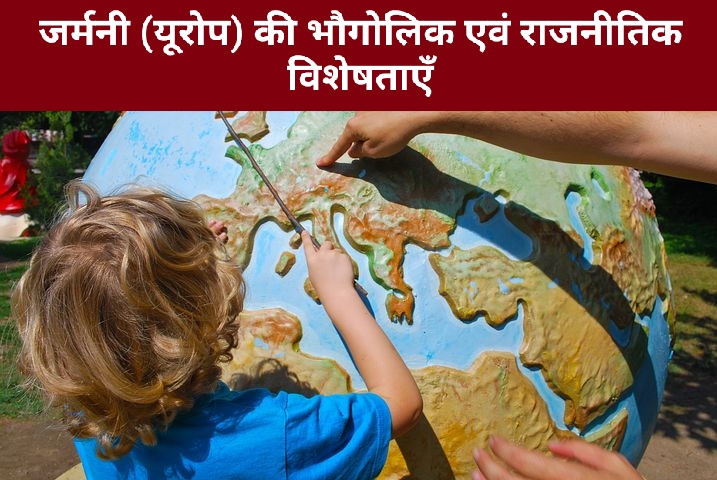
ऋतु परिवर्तन, ग्रहण, सुपरमून और विषुव क्या है | What is the change of seasons, eclipses, supermoons and equinoxes.
21 जून की स्थिति (June 21 position)-
21 मार्च के बाद से सूर्य उत्तरायण होने लगता है। फलस्वरुप उत्तरी गोलार्ध में दिन की अवधि बढ़ने लगती है, जिससे ग्रीष्म ऋतु का आगमन हो जाता है। 21 मार्च से सूर्य उत्तरी ध्रुव को प्रकाशित करना शुरू कर देता है तथा 23 दिसम्बर तक उत्तरी ध्रुव प्रकाशित होता है। अतः उत्तरी ध्रुव पर लगातार 6 महीने का दिन होता है। 21 मार्च से 21 जून तक की अवधि को 'उत्तरायण' कहा जाता है। 21 जून को सूर्य की किरणें उत्तरी गोलार्ध पर लम्बवत पड़ती हैं। इस दिन उत्तरी गोलार्ध में दिन सबसे बड़ा और रात सबसे छोटी होती है। इस स्थिति को 'ग्रीष्म अयनांत' अथवा 'उत्तर अयनांत' भी कहा जाता है। इस स्थिति में पृथ्वी का दक्षिणी ध्रुव लगातार छह महीने तक अंधेरे में रहता है। फलस्वरुप दक्षिणी ध्रुव पर शीत ऋतु होती है। From March 21, the sun begins to form Uttarayan. As a result, the daytime period in the Northern Hemisphere begins to increase, leading to the arrival of summer. From 21 March, the Sun starts illuminating the North Pole and by 23 December the North Pole is illuminated. Hence there is a continuous 6-month day at the North Pole. The period from 21 March to 21 June is called 'Uttarayan' . On 21 June, the rays of the sun perpendicular to the Northern Hemisphere. On this day the day is the largest and the night is the shortest in the Northern Hemisphere. This condition is also called 'summer solstice' or 'answer solstice' . In this state, the south pole of the Earth remains in darkness for six consecutive months. As a result, there is a cold season at the South Pole.22 दिसम्बर की स्थिति (Position of 22nd December) -
23 दिसम्बर से 21 मार्च तक पृथ्वी का दक्षिणी ध्रुव प्रकाशित होता रहता है। इस कारण से दक्षिणी ध्रुव पर लगातार 6 महीने का दिन रहता है। आतः 23 दिसंबर से 22 दिसम्बर की अवधि को दक्षिणायन कहा जाता है। 22 दिसम्बर को सूर्य की किरणें मकर रेखा पर लम्बवत पड़ती हैं। इस दिन दक्षिणी गोलार्ध में दिन सबसे बड़ा तथा रात सबसे छोटी होती है। इस समय सूर्य मकर रेखा पर सीधा चमकता है। फलतः दक्षिणी गोलार्ध में अधिक प्रकाश पड़ता है, इसलिए दक्षिणी गोलार्ध में लम्बे दिन व छोटी रातें वाली ग्रीष्म ऋतु होती है, जबकि उत्तरी गोलार्ध में विपरीत स्थिति रहती है। क्योंकि उत्तरी ध्रुव प्रकाशित होने के कारण कम ऊष्मा प्राप्त करता है। फलस्वरुप यहाँ शीत ऋतु होती है। इस अवस्थिति को 'शीत अयनांत' या 'दक्षिणी अयनांत' कहा जाता है। From December 23 to March 21, the South Pole of the Earth keeps illuminating. For this reason, there is a continuous 6 month day at the South Pole. Hence, the period from 23 December to 22 December is called Dakshinayan. On 22 December, the rays of the sun perpendicular to the Tropic of Capricorn. On this day, the day is the largest and the night is the shortest in the Southern Hemisphere. At this time, the sun shines directly on the Tropic of Capricorn. As a result, there is more light in the Southern Hemisphere, so the Southern Hemisphere has longer days and shorter nights, while the Northern Hemisphere has the opposite. Because the North Pole receives less heat as it is illuminated. As a result, it is winter here. This location is called 'cold solstice' or 'southern solstice' . जब सूर्य की लंबवत किरणें पृथ्वी के किसी भाग पर पड़ती हैं तो इससे पृथ्वी द्वारा ऊष्मा का अवशोषण अधिक होता है एवं जब सूर्य की तिरछी किरणें पृथ्वी के कितने भाग पर पड़ती हैं, तो ऊष्मा का अवशोषण कम होता है। उल्लेखनीय है कि दोपहर अधिक गर्म एवं सुबह तथा शाम में कम गर्मी होती है, क्योंकि दोपहर में सूर्य की किरणें सतह पर सीधी पड़ती हैं जबकि सुबह तथा शाम को सूर्य की किरणें तिरछी पड़ती हैं। When the sun's perpendicular rays fall on any part of the earth, it increases the absorption of heat by the earth and when the oblique rays of the sun fall on how much of the earth, then the absorption of heat is less. It is worth mentioning that in the afternoon, it is hotter and in the morning and evening there is less heat, because in the afternoon the rays of the sun fall directly on the surface while in the morning and evening the rays of the sun are oblique.21 मार्च तथा 23 दिसम्बर (विषुव) की स्थिति [The position of March 21 and December 23 (equinox)] -
21 मार्च एवं 30 दिसम्बर की स्थितियों में सूर्य की किरणें विषुवत रेखा पर सीधी चमकती हैं। इस समय समस्त अक्षांश रेखाओं का आधा भाग सूर्य का प्रकाश प्राप्त करता है। इन दोनों तिथियों को संपूर्ण विश्व में दिन तथा रात की अवधि बराबर होती है। फलतः इस स्थिति को 'विषुव' कहा जाता है। 23 दिसंबर को उत्तरी गोलार्ध में शरद ऋतु होती है एवं दक्षिणी गोलार्ध में बसंत ऋतु होती है। इसके विपरीत 21 मार्च को उत्तरी गोलार्ध में बसंत ऋतु एवं दक्षिणी गोलार्ध में शरद ऋतु होती है। अतः 21 मार्च वाली स्थिति को 'बसंत विषुव' एवं 23 दिसंबर वाली स्थिति को 'शरद विषुव' कहा जाता है। In the conditions of March 21 and December 30, the sun's rays shine directly on the equator. At this time half of all latitude lines receive sunlight. Both these dates have equal duration of day and night all over the world. As a result, this condition is called 'equinox' . On 23 December, it is autumn in the Northern Hemisphere and spring in the Southern Hemisphere. In contrast, on March 21, there is spring in the Northern Hemisphere and autumn in the Southern Hemisphere. Hence the condition of March 21 is called 'Spring Equinox' and December 23rd is called 'Autumn Equinox'.सूर्यग्रहण (Solar eclipse)-
जब सूर्य तथा पृथ्वी के मध्य चंद्रमा आ जाता है तो पृथ्वी पर सूर्य का प्रकाश न पढ़कर चंद्रमा की परछाई पड़ने लगती है। इस स्थिति को 'सूर्य ग्रहण' कहा जाता है। सूर्य ग्रहण हमेशा अमावस्या में ही होता है। चंद्रमा के कक्ष तलों में 5 अंश का झुकाव होता है। इस कारण यह प्रत्येक अमावस्या को घटित नहीं होता है। जब सूर्य का आंशिक भाग जाता है, तो उसे 'आंशिक सूर्यग्रहण' कहा जाता है। जब पूरा सूर्य छिप जाता है तो उसे 'पूर्ण सूर्यग्रहण' कहा जाता है। पूर्ण सूर्य ग्रहण के समय सूर्य की परिधि पर 'डायमंड रिंग' अथवा 'हीरक वलय' की संरचना बन जाती है। When the moon comes between the sun and the earth, the moon's shadow begins to fall on the earth by not reading the sunlight. This condition is called 'solar eclipse' . Solar eclipse always occurs on Amavasya. The lunar orbits of the moon have an inclination of 5 degrees. For this reason, it does not occur on every Amavasya. When the Sun gets partial, it is called 'partial solar eclipse' . When the whole sun is hidden it is called 'full solar eclipse' . At the time of complete solar eclipse, the structure of 'diamond ring' or 'diamond ring' is formed on the circumference of the sun.चंद्रग्रहण ( Lunar Eclipse)-
जब सूर्य तथा चंद्रमा के मध्य पृथ्वी आ जाती है, तो सूर्य का प्रकाश चंद्रमा तक ना पहुँच कर उस पर पृथ्वी की छाया पड़ती है। जिसके कारण चंद्रमा पर आंशिक या पूर्णतः अंधेरा हो जाता है। इस स्थिति को 'चंद्रग्रहण' कहा जाता है। चंद्र ग्रहण सदैव पूर्णिमा की रात को ही होता है, किंतु प्रत्येक पूर्णिमा को चंद्रग्रहण नहीं होता है। पूरा चंद्रमा ढक जाने पर 'पूर्ण चंद्रग्रहण' होता है। इसके विपरीत आंशिक चंद्रमा ढकने पर 'आंशिक चंद्रग्रहण' होता है। When the Earth comes between the Sun and the Moon, the Sun's light does not reach the Moon and cast an Earth shadow on it. Due to which the moon becomes partially or completely dark. This condition is called 'lunar eclipse' . The lunar eclipse always occurs on the full moon night, but there is no lunar eclipse on every full moon. When full moon is covered, 'full lunar eclipse' occurs. In contrast 'partial lunar eclipse' occurs when partial moon is covered.टीप (Note)- सूर्य, चंद्रमा तथा पृथ्वी की एकरेखीय स्थिति को 'सिजिगी' या 'युति-वियुति बिंदु' कहा जाता है। इसके कारण सूर्यग्रहण और चंद्रग्रहण होता है। जब सूर्य तथा पृथ्वी के बीच चंद्रमा होता है, तो उसे 'युति' कहा जाता है। ऐसी स्थिति हमेशा चंद्र ग्रहण के दौरान ही देखने को मिलती है। जब सूर्य तथा चंद्रमा के मध्य 'पृथ्वी' होती है तो उसे भी 'वियुति' कहा जाता है। ऐसी स्थिति हमेशा चंद्र ग्रहण के दौरान भी उत्पन्न होती है।
The unilateral position of the Sun, Moon and Earth is 'Sijigi' or 'Uti-viyuti-point' is called . This causes solar eclipse and lunar eclipse. When there is a moon between the Sun and the Earth, it is called 'Yuti' . Such a situation is always seen during the lunar eclipse. When there is 'Earth' between the Sun and the Moon, it is also called 'Viuti' . Such a situation always occurs even during a lunar eclipse.सुपरमून (Supermoon)-
यह एक खगोलीय घटना है। चंद्रमा पृथ्वी की परिक्रमा दीर्घ वृत्ताकार परिपथ में करता है। इस वजह से चंद्रमा व पृथ्वी की दूरी तथा स्थिति परिवर्तित होती रहती है। सुपरमून वह स्थिति है जिसमें चंद्रमा पृथ्वी के सबसे निकट होता है। इस स्थिति को 'पेरिजी फुल मून' भी कहते हैं। इस दशा में चंद्रमा पहले की अपेक्षा 14% बड़ा तथा 30% ज्यादा चमकीला प्रतीत होता है। This is an astronomical event. The Moon revolves around the Earth in a circular circle. Due to this, the distance and position of the moon and the earth keeps changing. Supermoon is the position in which the Moon is closest to the Earth. This condition is also known as 'perigee full moon' . In this case the moon appears to be 14% larger and 30% brighter than before. आशा है, यह लेख परीक्षार्थियों के लिए उपयोगी होगा।धन्यवाद।
RF Temre
INFOSRF.COM
(Watch video for related information)
संबंधित जानकारी नीचे देखें।
(Watch related information below) 👇🏻

आशा है, उपरोक्त जानकारी उपयोगी एवं महत्वपूर्ण होगी।
(I hope the above information will be useful and important. )
Thank you.
R. F. Tembhre
(Teacher)
infosrf.com


.jpg)


Comments